Ancient science to the rescue
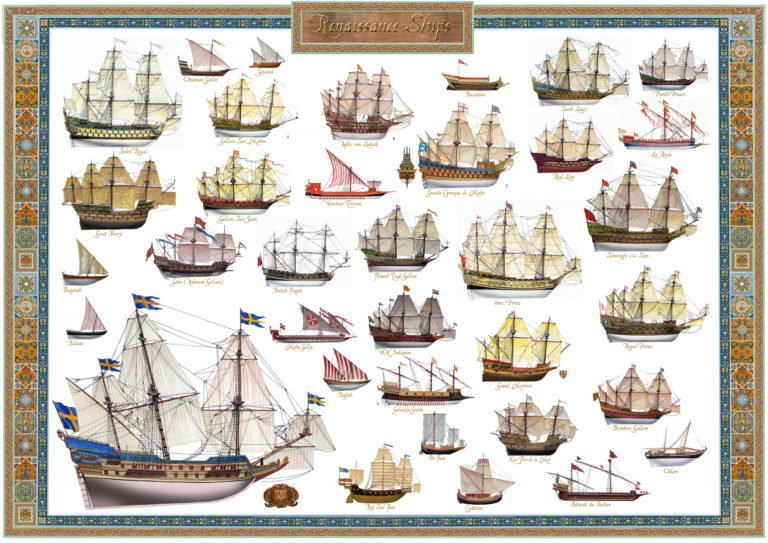
The Renaissance begins, according to most authors, in Italy, notably in Florence and Venice. In particular because the wealth of generous and enlightened merchants and Condotierres, bringing patronage to artists that took their inspiration and “rediscovered” classical antiquity. Called locally Rinascimento, it originated from the Trecento from the fourteenth century and gained the rest of Europe in the sixteenth century. Many date it from the fall of Constantinople in 1453, but ended at an unspecified time, some speaking of the death of Charles V in 1558. But it is especially a period marked by the great naval discoveries, maps creations, gunpowder, rudder and compass, and it is also the constitution great merchant and military empires.
On the purely naval side, we note the emergence of an emblematic vessel of that era, both building trade and war faster, the Galleon. It does not, strictly speaking, replace the Carrack, which is maintained at its side until the end of the sixteenth century. Carracks and galleons will be instruments of exploration and wealth for the Portuguese, the Spaniards and then the Dutch. This chapter also includes a transition ship of the modern age, which is no longer of the Renaissance, but classified here for convenience: The ship-of-the-line, ma-o-war, a truly military tallship and logical evolution of the Galleon. It was born at the beginning of the XVIIth century, and evolved constantly to find its culmination around 1840.
Eastern ships :
- Balam
- Baqarah
- Fune de plaisance
- Ho Fune
- Jonque de pakoi
- Odam
- Pattawar
- Prao Bedang
- Prao Mayang
- Prao Pendjaleng
Carracks :
- Flor de la Mar
- Sao Gabriel (Nau)
- Vasco de Gama Carrack
- HMS Regent (Henry VIII)
- Mary Rose (Henry VIII)
- Great Harry (Henry VIII)
- La Grande Hermine (Francis I)
- La Grande Françoise (Francis I)
- Marie de la Cordelière (Francis I)
- Malta Knights Great Carrack
Galleys, Galeazza & Galeas :
- Venetian Galeass (Lepanto 1571)
- Venetian Galley (Lepanto 1571)
- HMS Grand Mistress (Henry VIII Galeass)
- Invincible Armada Galleon
- Ottoman Admiral Galley
- Papal Galeass (Lepanto)
- Maltese Galley
- Turkish Galiot
- Göke (Kemal Reis)
- Late Carwel
- Gribane
- Fluyt
- Spanish war Pinnace (1588)
- Moliceiros
Ships-of-the-line (XVIIe):
- Royal Prince
- Sovereign of the seas
- HMS Prince
- 1650 British Frigate
- Soleil Royal
- Saint Louis
- Vasa
Galleons :
- HMS Red Lion 1580
- Adler von Lübeck
- “Golden Line” Spanish Galleon
- Flemish Galleon 1590
- V.O.C Dutch Galleon: Batavia
- Invincible Armada San Juan Galleon, 1588
- John Hawkins Galleon, 1588
- Golden Hind, Sir Français Drake Galleon
- San Juan Bautista, Japanese Galleon
Venetian Galley
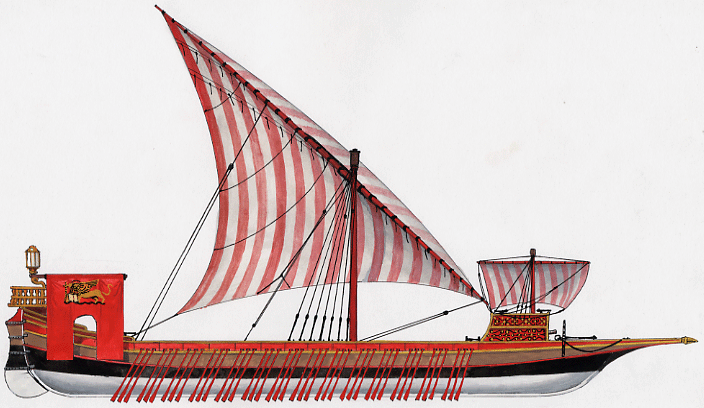
The Venetian military galley, heir to both the mighty Byzantine Dromons and the distant Roman Imperial Triremes, was one of the best examples of their evolution, at a time when the still-rising galleons had not eclipsed them. Compared to the carracks, which boasts a powerful artillery, the galleys are less armed but quicker, and independent of the wind.
Naval battles are always solved by boarding as in the past, but firearms give the embarked troops the possibility to engage the enemy at better ranges. The Galley presented here is already imposing, signaling itself as a command galle. It is a “trireme”, in the sense that it is given three rows of oars, but at the same level.
On the other hand, these oars are handled by three to four men each. It is the “a scaloccio”, rowing style, a term invented by the Italians in the Middle Ages but often used to describe antique swimming systems. The latter, with its 84 oars handled by 336 men, had in front a chasing cannon of large caliber (bombard), and four lighters pieces, sheltered inside the forecastle. To the ballistae have succeeded the lighter culverins on articulated side poles. Inevitably, the rigging is Latin, and most of the time on a single mast.
Vasa

The Vasa is one of those great ships (they are no longer called galleons, but form a part of this family born at the beginning of the last century), which bore all the royal magnificence together with a formidable dissuasion power towards Sweden’s naturals foes, like Russia. In this case it was originally called the Nya Wassan, a large sailing ship of 1400 tons, with planned 1150 m2 of sail. The head of her mainmast culminated at 50 meters, for a full length of 66.50 m from the lantern of the stern table at the edge of the parrot’s hune.
She carried 133 crew and 300 soldiers and servants, for 64 bronze guns divided into forty-eight 24 pounders, eight 2 pounders, two one pounders, and six mortars. No less than 80 tons was disseminated on three decks, the lowest one being just 1.20 m above the waterline. She was built under personal instructions from King Gustav Adolf (who reigned from 1611 to 1632), then at war with Ferdinand II of Habsburg.
She was built and launched in 1627 in Blasieholmen Island, and completed in the spring of 1628, the ceremony having been celebrated with pomp. The king would have even said these words: “After God, it is the fleet that decides the prosperity of the Kingdom.” Still, the Nya Wassan was towed to the naval artillery dock not far from the palace of the three crowns (“Tre Kronor”).
There she had to be armed, receiving her artillery but also ballast and crew, basically to be prepared to join the fleet. On August 10, 1628, she began her first service voyage to join Alvsnabben (Stockholm Archipelago), where the rest of the fleet was anchored. The jubilant crowd was massed on the jetties to witness the departure of the famous and magnificent ship.

The weather was beautiful, with a radiant sun, and the ship did not unfurl its sail until after being towed to Södermalm. Crewmates lowered the foresail, brigantine, great and the little topsail. A slight south-southeast breeze was then blowing. But after barely a mile, a sudden gust of wind drowned the ship, which rolled down to the level of the lower battery, the ports of which were wide open to gun salute the King. When the gust ceased, Vasa, far from straightening up, had pitch increasing until the water penetrated to the ports. Foreseeably she completely capsize in a few moments, its sails taking water, her holds filled very quickly.
She sank, for she had been heavily weighted to compensate for the weight of her artillery, in front of an incredulous public. This was nothing short of a national catastrophe: About fifty people were drowned, crew, artillerymen, But also officers and especially high-ranking officers of the Swedish Army who traveled with women and children… Since the ship cost was a whooping 100,000 Riksdaler (60 million Euros today), a commission of inquiry was convened as of the next day in order to decide on the responsibilities of each.
The boatswain, Jöran Matsson, who was the most seriously accused, defended himself with much conviction, and eventually convinced the jury that the ship had been too heavily loaded at the top and in his opinion – he was not an engineer or a naval carpenter – The hull was too narrow for her high profile. He confirmed the fact that during roll tests the ship had already behaved badly. When Hein Jacobsson, the final boatmaster of the ship, said that the final plans had been drawn on these precise specifications by the King himself…
The investigation also questioned the artillery intendant Erik Jönsson, Lieutenant Gierdsson, in charge of the rigging, and eventually the audience closed without clear responsibility. The Vasa could not be recovered, so teams did their best then to dismantle her large mast, which protruded from the water, in order to clear the navigation.

In 1664, a salvage operation by Hans A. Von Treileben was only partially carried out by sending divers to empty the contents of the vessel, including the 50 large bronze cannons. But the story does not end there: In 1956, a maritime archaeologist managed to trace the ship, buried under tons of mud.
This famous natural preservative, the Scandinavian mud, was considered acidic, antibacterial, and moreover woodworms, usual gravediggers and natural recyclers of hulls, did not support the icy waters of the Baltic. It was the miracle that made it possible to dig up valuable archaeological vestiges from the sea, such as the famous Vikings boats.
Four years of hard work was needed, financed largely by the government. Finally In 1961, the Vasa was removed practically intact from its muddy cradle… Only the paintings had disappeared.

Archaeologist Anders Franzén found the trace later with pigments encrusted in the veins of the wood and a colored reconsititution was done. The Vasa hull was carefully washed and treated with polyethylene glycol. A hangar was quickly built to completely isolate her from the outside, which became the temporary museum of Djugarten in Stockholm.
She is now the Vasamuseet, a large building which besides the ship, also hold nine exhibitions dedicated to the 14,000 intact wooden objects recovered in the ship and notably its extra sails, the only ones recovered from that time in the world. The Vasa is currently one of the most popular attractions in Sweden, and its visit is essential for going through Stockholm. The Vasa became invaluable for the knowledge of the techniques of the time, and many posterior reconstructions rely heavily on studies made out of her.
Odam
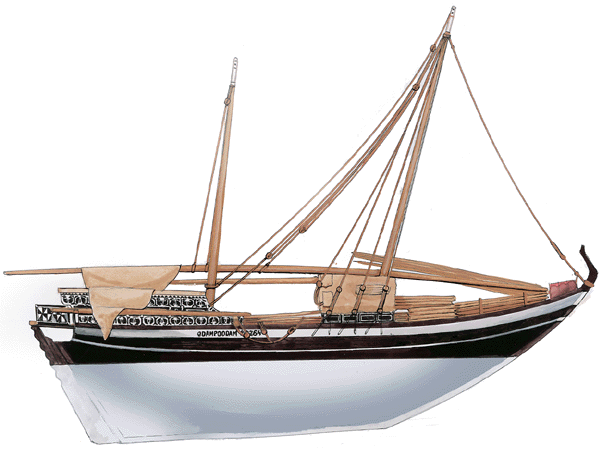
The Odam (here the Odam Poodam), is a cargo characteristic derived from Dhows used in Southern India, and originating in the Laccadives archipelago. She features two leaning mastswith Arab sails (Lateen-Setie), but tops a jib on a short boat-out. As always, the bow is very sharp, though rounded, and the stern sharp and receding.
Coconut wood was used for the curves. Odams had a crew of 4 to 6 men, housed in the rear castle covered with a masted roof, and supplemented by a central hut used for the storage of perishable goods. These vessels generally measured 18 meters for 5.18 meters wide with a draft of 4.30 meters. They load their cargo into a large, one-piece, decked hold. The Odam, which was still in use recently, is beginning to disappear slowly. Their ancient origin remains mysterious.
Grand Mistress
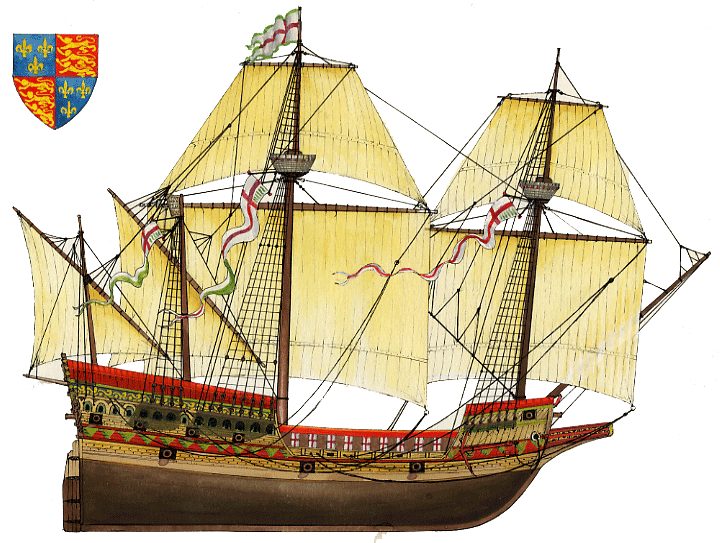
The Great Mistress was a singular ship of Henry VIII’s fleet of England, a contemporary of the Great Harry, halfway between a carrack and a galley.
Modern galleons did not appeared until the middle of the sixteenth century, and the Grand Mistress was unquestionably a precursor. It was classified as a “galleass” on the fleet registers, but an engraving of the time (unless it is an involuntary omission of the engraver, not necessarily a marine engraver), represents it without the least trace of rows, necessary to consider it as such. The term “galleon” was adopted for overseas ships with oars until the seventeenth century.
As a galleon he would have been very well armed, six big bombards and 14 couleuvrines, as well as twenty or so heavy arquebus. Her rigging was that of a galleon, with a low, shallow hull and low castles differentiated her from carracks of the time, making here a steadier and faster ship. We can therefore understand through this precursor how the Galleon quickly established herself and succeeded to the carrack in all Christendom.
Tchektirme
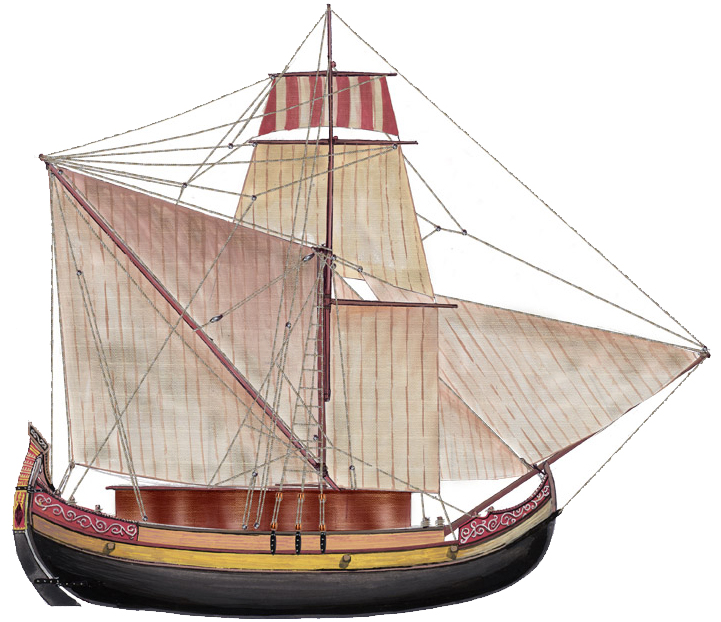
The Tchektirme was the typical Turkish workboat, a Mediterranean variant of the flat-bottom coasters rigged with a fore-and-aft rig. This type of ship, linked to the Greek Skapho (a small fishing boat), and the large Sakouleiva, was long-derived from the Byzantine Khelandion (chaland). The French Trecandin was also related to these ships, but with a somewhat different rigging.
Great Harry
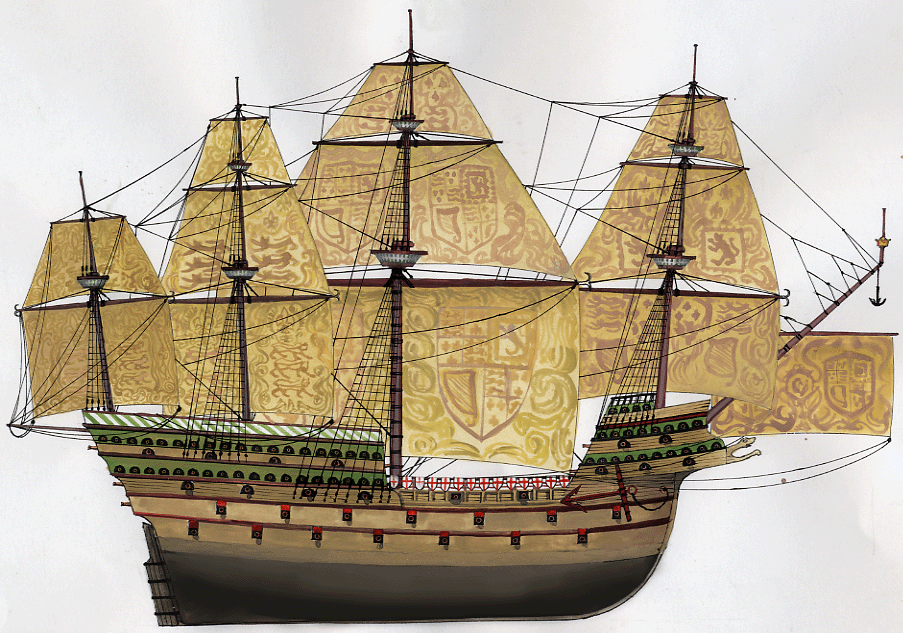
Successively called Imperial Carrack, Henry Imperial, Henry VIII’s Royal Carrack was built in 1514 on orders to replace the Regent, sunk previously after a duel with the French Admiral Ship Mary de la Cordelière (which sank too). Known only from launch as the Great Harry she has been on par with Portuguese Santa Catarina do Monte Sinai, the largest carrack ever built.
Harry Grace a Dieu’s (“By the grace of god”) height was reduced in 1536 to avoid excessive roll, and its rigging lowered. Her artillery was quite impressive for the time, with 184 heavy bombards, up to 251 guns of all calibers. She famously carried the king to Francis I’s Field of the Cloth of Gold in 1520 for an historical meeting. Afterwards her career was relatively uneventful, until she burn at Woolwhich in 1553.
VOC Galleon
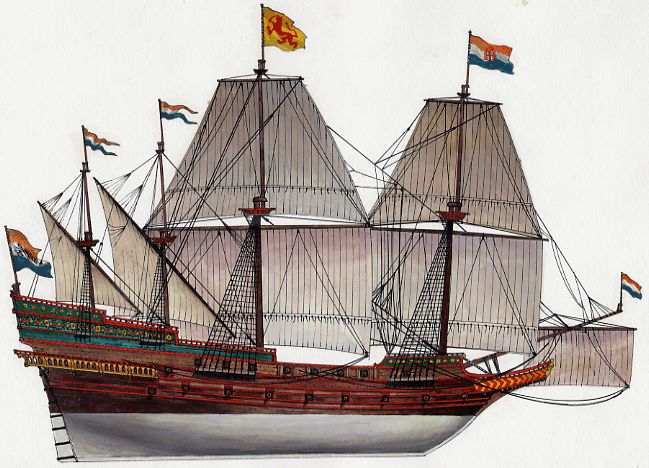
After their independence the Dutch set up the largest trading empire of their time. Large fleets of versatile ships, carrying large quantities of goods, especially spices and silk, but also well-capable to defen hemselves with powerful defensive artillery.
The lesson of the British corsairs pitted against Spanish trade had been retained. This type of ship specifically used by these large far-east trading companies would later be called “Indiaman”, up the XVIIIth Century.
The VOC galleons, a real multinational with current standards, and at that time a state within the state, with its own army, regulations, police, justice, sent galleon convoys powerfully escorted to these mysterious lands of the “far east”, Indonesia, Malaysia and India.
The enormous price of the commodities transported justified the constitution of this empire. One of these galleons, the Batavia, was reconstituted in the 1990s by the Dutch. She could very well lend itself to an adventure movie so much the history of its mutiny has nothing to envy to that of the Bounty.
Baqarah
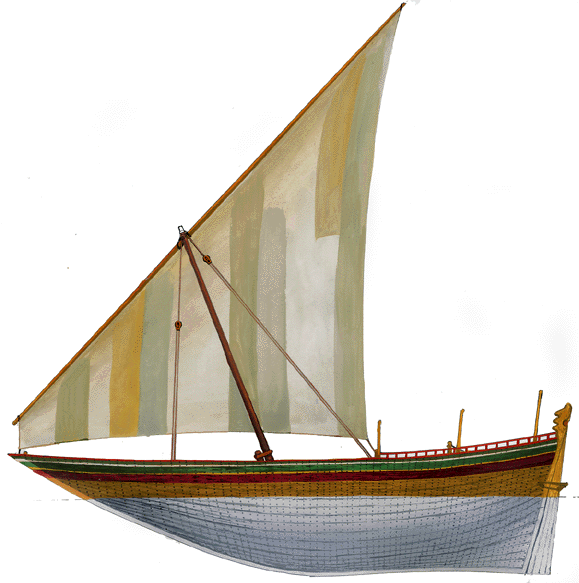
The Baqarah has nothing to do with the gambling table of the casino: This was an old trading ships, close to the Bedan, having a particularly inclined bow, but still roomy and sturdy with high draft.
She is a pure cargo ship that appeared at the end of the Middle Ages, disappearing since the turn of the 20th century. Its antenna was particularly long since it extended well beyond the length of the ship, and came to rest on poles in the back.
Galleazza Grossa
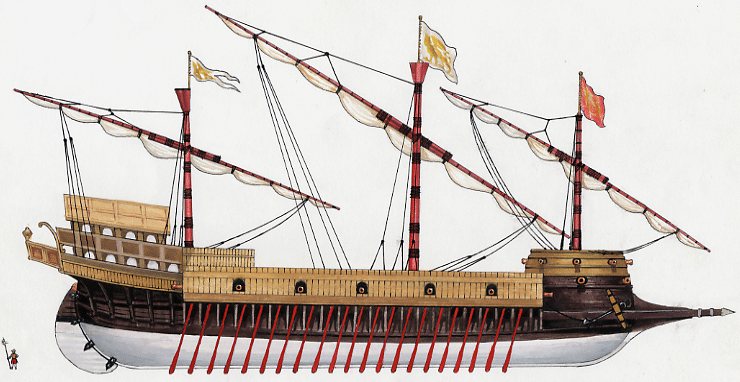
The “Galeazza Grossa”, a great galley of the fifteenth century, and “secret weapon” that won the battle of Lepanto – the greatest galley battle in history – and turn the tide of history for the Mediterranean world, appeared as a heavier version of the Galea.
The latter was then a small vessel (15 meters), but soon it was enlarged and redesigned to carry artillery like the galleon. 80 meters long, with a complete deck, about 20 guns, the Galeazza was characterized by powerful “castros” like previous Byzantine ships, in place of the gun deck, to fire in all directions. Because of her weight, the Galeazza had a strong draft and required between 4 and 7 rowers per side, manned by a crew, gunners and troops, about 800 to 1000 men in total.
Above all, these heavy galleys were rigged with three Latin sails. But as they were seen like compromises between carracks and galleys, they were also built by the English, the French, and were in use on the coasts of Holland. Rigged like galleons, they could easily be confused with the latter type. Venice unleashed these six Galeazza Grossa in line at the battle of Lepanto on October 7, 1571, which largely contributed to the victory of the Christian coalition against the Turks.
Their height, formidable firepower, well distributed widely contributed to this victory. Galleys disappeared in the middle of the eighteenth century, just like the galley itself, especially because of the incompatibility of combining efficiently strong artillery and too many rowers. Moreover, the defeat of the invincible Armada in 1588 proved the inefficiency of Spanish Galeass outside the Mediterranean.
Prestige French Carrack: Marie de la Cordelière (1505)
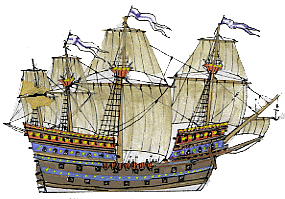
The Marie de la Cordellière (1505) suspected to be the name of a prominent mistress of Francis the 1st (Henry VII did the same with the “grand mistress”) was the bedrock of the newly-born French National Navy, as a response to a similar move from Henry VIII. This carrack (French “Caraque”) was the first known and admiral ships of the French Navy which later really took shape under Louis X.
There is no known representation of this ship but her history is much better known. This carrack was issued to civilian shipbuilding, borrowing many elements to the Spanish and Portuguese ships, but also Venetian design. They were ancestors of the first galleons, cargo ships with a defensive artillery carried at the last end. Under Louis X, about fifty carracks were specially equipped for war. Traditionally they carried 8 to 20 pieces of heavy caliber, bombards in the lower decks, and a hundred smaller iron pieces more arquebus-size than cannons.
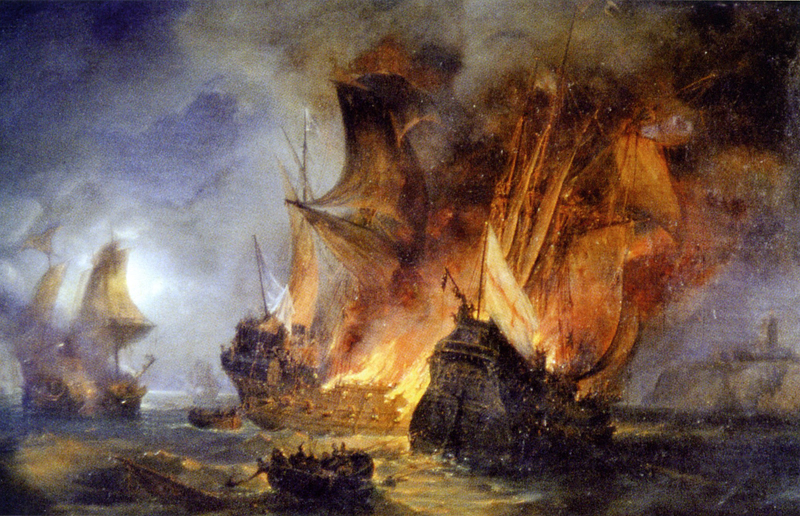
Shots were fired at close range as a prelude to any boarding assault. Marie de la Cordellière was known to be the flagship of the fleet in 1505. She duelled with Henry VIII’s HMS Regent in 1512 in the Bay of Camaret and their fight remains legendary. These two ships rigged each other and were set blazed during the battle, the fire being communicated to the powder reserves. Both ships exploded and sank in a short time. The wreck of La Cordellière was recently found by a team of Breton divers. Henry VII built the formidable Great Harry to replace the Regent, while the French built two other huge war and prestige carracks, the Grande Hermine and Grande Francoise. Read More about Marie de la Cordelière and the battle of St Mathieu.
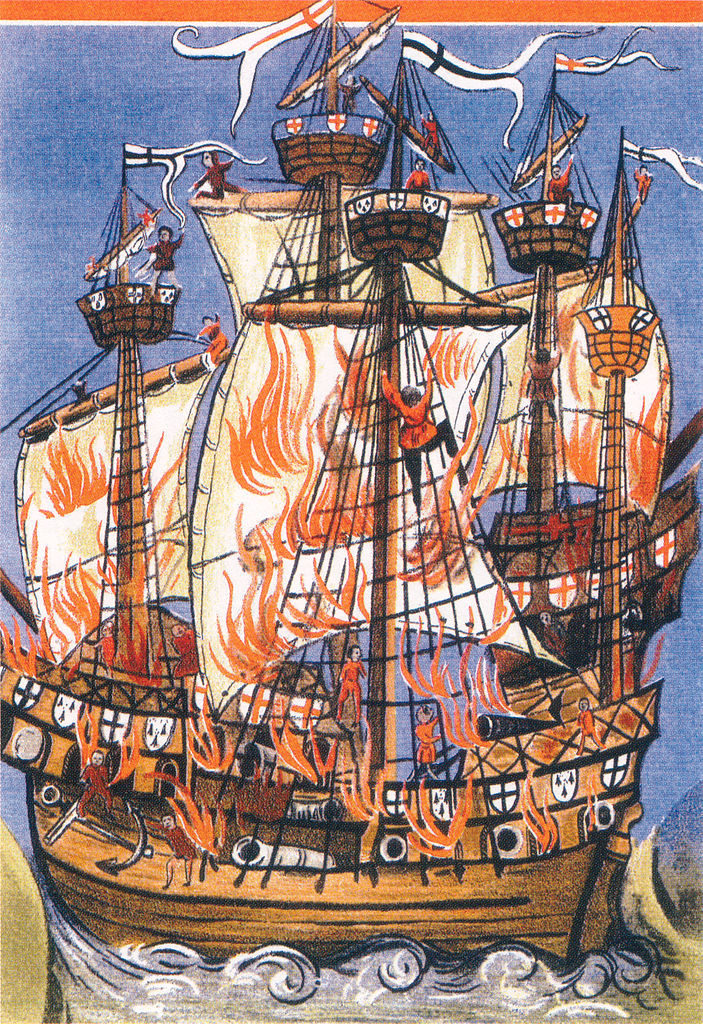
Geobukseon
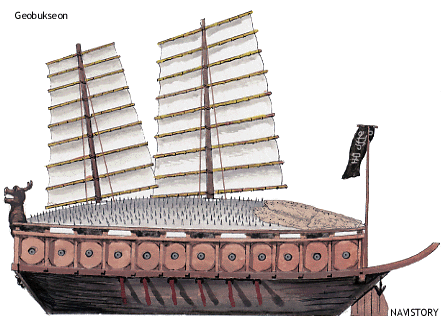
The Koreans are so proud that they have made at least two reconstructions of these ships relatively unknown to Westerners. Undoubtedly the centerpiece of the marine arsenal of the Chosons, they come from a line of military ships quite surprising originally imagined to contain massive raids of Japanese pirates. The turtle-boat – so called because of its domed roof made of iron scales – was indeed an invention that Leonardo da Vinci would certainly not have denied:
It is simply the first battleship. Its propulsion was assured both by short oars, and thin battened veils, constituted as on the junks of the time, of canvas issued from rice mat, maintained by bamboo yards, pivoting on the axis of the mast And very easy to stir.. from the inside. For in the vast comparative bestiary, the hedgehog would have been equally appropriate to deal with this ship.
The roof was, in fact, devoid of any access (which was made by the back of the gallery), but on the other hand furnished with sharp points, generally hidden by boots of straw, so as to discourage collisions. What’s more, this roof was high enough for the junks of the time. To this passive protection was added a formidable battery of cannon mounted on rolling carriages (6 to 12 per side), and the arms of the men on board.
The dragon’s head, at the beginning lower, was in fact the exit of a barrel pulling from the front. Later, this head served either as a flamethrower in the manner of the Byzantine siphons, or as a thick smoke to conceal the maneuver. The Geobukson (or Kobukson) is large and high, relatively slow but stable, and Eminently formidable. Few of them were produced, but only at the instigation of Yi-Sun-Sin, which took over the “naval base” of the province of Cholla.
Korea was in open war with Japan, whose fleet had heavy and powerful ships. The turtle ship is mentioned from the time of King Taejong (1400-1418), but remained in the prototype stage. It was not until the Ijmin war in 1592 that the Admiral took up the idea of this ship and allowed it to pass to the stage of mass-production.
Three will see the light of day in 1592 and two others in 1595 which will have decisive weight in the battle alongside Panokson, largely the majority. Their action can be compared with that of the handful of Venetian Galleasses at the battle of Lepanto.
Balam
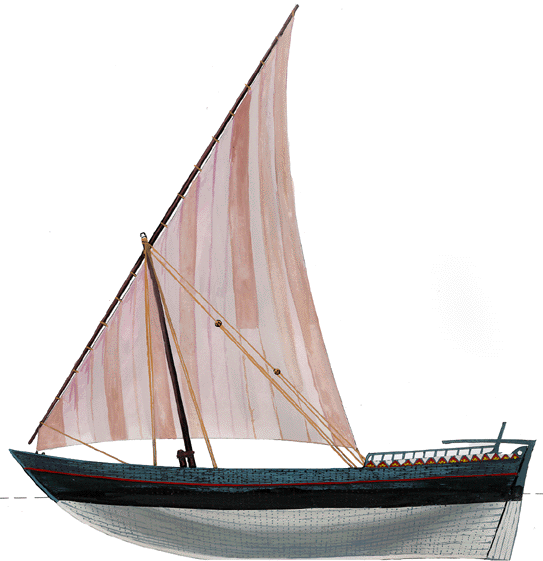
The Balam was a kind of Arabian dhow of the Persian Gulf characterized by a curved bow, limited dimensions and a capacity to access rivers. This type of ship began to disappear with the industrialization of the Middle East in the last fifty years. Its origin is unknown, but probably the Renaissance.
Red seal Fune
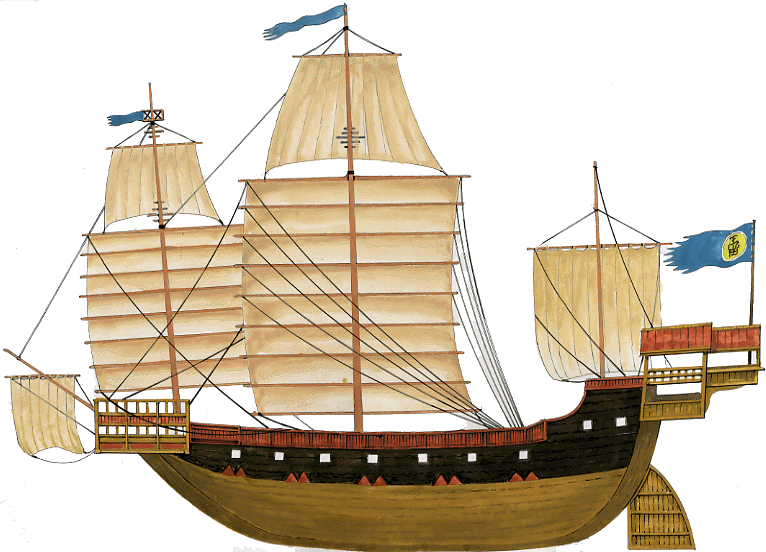
Author’s recreation of a “Palace Fune” and Red Seal ship
The term “Fune” means in general Japanese a ship, whatever its size. Like the Ho Fune previously discussed, the Fune has been declined in many variants resulting from Chinese construction techniques. Even as Japan came into contact with the Portuguese navigators and their Galleons, they continued to build traditional Fune. The one presented here is a large sized ship with three main masts, of the “red seal” type (朱印船 Shuinsen).
She has three decks and superimposed galleries, from a rendition on a wooden print of the Sakoku (Edo) era. The superposed and partially latticed sails as well as the galleries and the parrot at the front with a hierarchy of mast sizes distributed as on the Galleons testified to some Western influence.
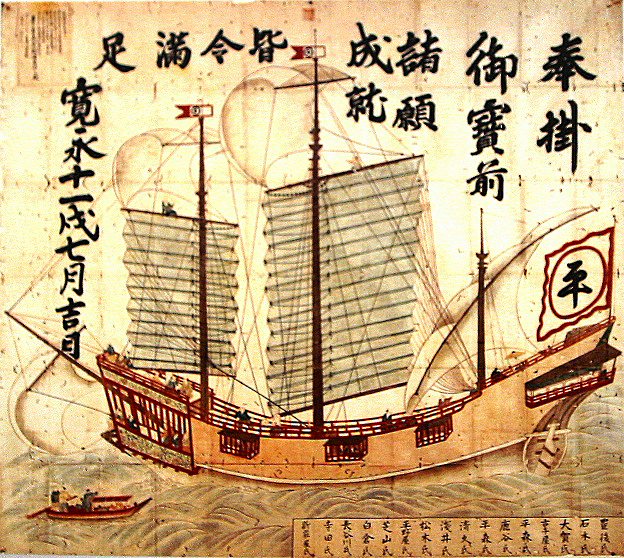
Red Seal Ship
For the rest, this Fune had a prismatic hull with a flat bottom akin traditional junks. Some could be armed with guns, but the one presented here had a purely civilian vocation. The Japanese will continue to build this type of ship until the mid-17th century. They were extinguished with the Meiji era.
Red Seal ships were particularly influenced by the Portuguese. From a time of opening to world trade, they were armed merchant vessels bound for Southeast Asian ports. They presented a red-sealed letters patent issued by the early Tokugawa shogunate and made regular trade excursions around 1600-1635.
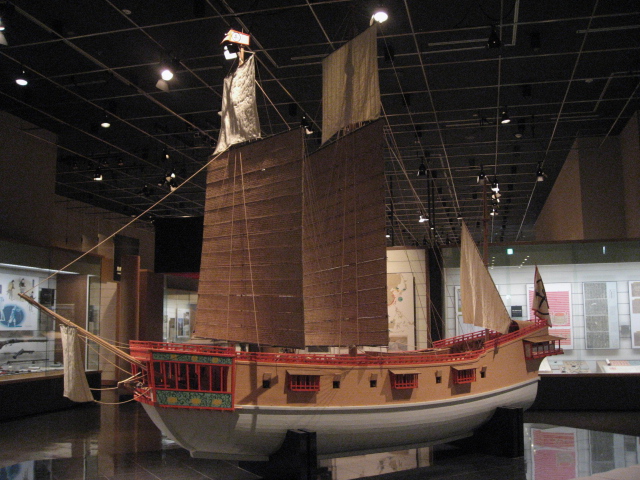
Red seal ship model, early Edo period, National Museum of Japanese History in Sakura, Chiba.
In all about 350 of these ships traded as far as Indonesia, Southern Asia, Malaysia, China (Formosa and Macau only), and the Philippines. They were as large as European late carracks and galleons, at 500 and 750 tons for about 250 crewmembers, international (often Dutch and European pilots). They exported silver, diamonds, copper, swords and other artifacts, and carried back home Chinese silk and Southeast Asian products like sugar, rare wood, and deer skin. Small Japanese enclaves appeared at each trading point.
They were fierce warriors and known as such, and became for some master-less Samurais called Ronin, well-paid and praised mercenaries. Some local rulers hired them in their regional fights, like in Siam against Burma. Their only competitor here was the powerful Dutch East India Company (VOC). One of these ships also reached India and Tenjiku “Indie” Tokubei became very famous after relating his adventures, the Marco Polo of Japan.
It is well possible these ships also fired on Spanish Galleons, which were not well seen either by the Shogunate. However in 1636 with the Introduction of the Sakoku policy links with the foreign world were severed and the Japanese trade fleet disappeared completely. From then on, foreign sailors setting foot on Japan for any reasons were put to death. The country would be opened by Force in 1854 by Commodore Perry.
Ho Fune
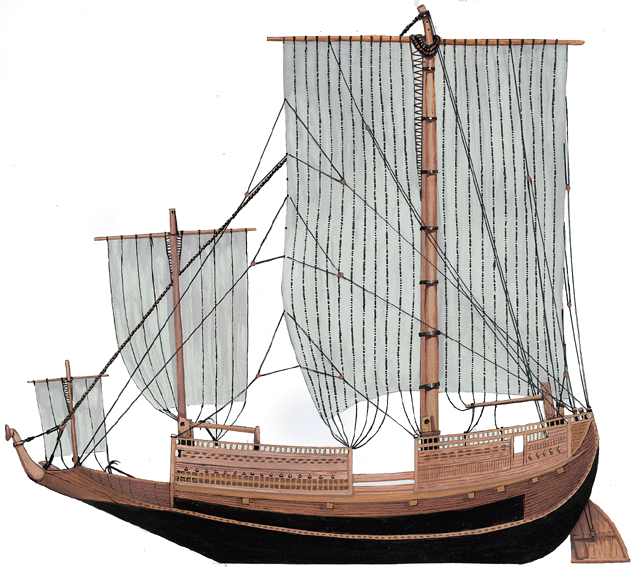
Japan’s shipbuilding industry was largely inspired by the junks that ran aground on its shore, and more rarely those that traded with the archipelago. As colonizers of Korea, the Japanese of the Middle Ages used junks very early. As a result, the Ho Fune, which appeared before the first contacts with the Portuguese in 1636, betrayed a wide Chinese influence but also Malay, or even Arab, as evidenced by its prow with a long inclined bow.
On the other hand, their hull had a section in tears, with the rear much more massive than the front, tapered, a large axial rudder, more typical junks. The rigging corresponded to this declining width of the forward bow, with its main mast at the rear and two others decreasing in size.
The sails are rectangular, in height, and consist of vertical stripes connected to the center (above) or battened in bird feathers. These were merchant vessels, and the smaller ones carried only one sail for fishing. They often had a figurehead at the head of Dragon or Snake…
Portuguese Nao Flor de la Mar
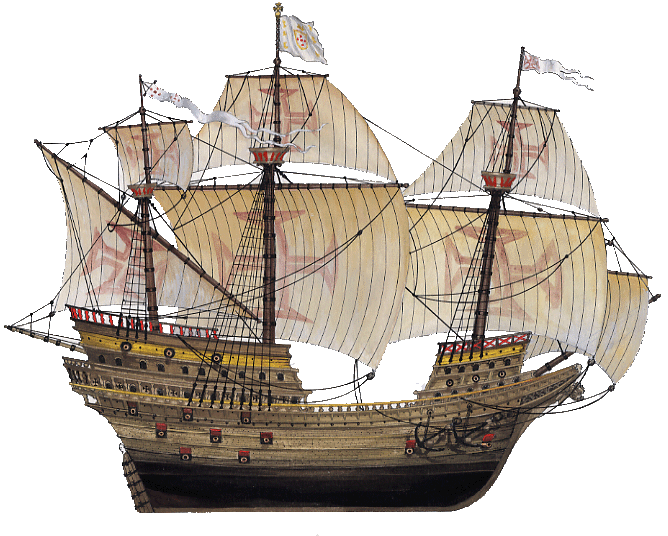
Example of “Nao” at a time when the Portuguese Caraques had nothing to do with the “naves” of the Middle Ages, this ship was with the “Trinidad”, one of the most powerful units of its time. The illustration is an interpretation of the engraving of “Roteiro de Malacca”.
An example among others of the know-how of the Portuguese at the time when they founded their empire. In order to defend their convoys or “Mudes”, they put on line of buildings able to defend it against any intrusion adverse.
The Flor de la Mar was perhaps a “nao”, a nave in Portuguese, because the classic lateral reinforcements or porticos are absent from these flanks, which pleads for a traditional construction of the South, on board. The engraving from which these illustrations are derived comes from the Roteiro de Malacca. It seemed to argue in the direction of a ship with six or seven decks, which was considerable.
The relative dispersal of the artillery typical of this period is also noted. The galleons of the sixteenth century will distribute them more effectively. As a result, the building was to measure 60 meters overall, for a height at the waterline at the handrail of the last bridge of the 20-meter aft deck.
Its width, like any round ship of the time, at the ratio of 3/1, should be 20 meters at the waterline, the tops being much finer according to the “pear shape” of its section. With 36 pieces of main artillery, not counting the mangonels and stones that could be adapted to the windows, it was a unit of first strike, considered as the most powerful of its time.
Santa Maria
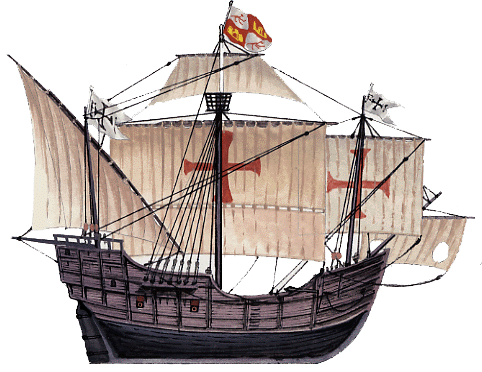
“Nao”, Carrack or Caravel were famous names, and the Santa Maria, in between these types, was the flagship of Christopher Columbus during his expedition to “indies”. This reconstruction here is that of a “Mixed Caravel” with caravel attributes but squared rigging.
At one time Cogs, Hulks, Carracks and Navas/Naos (Distinction was made especially on rigging and tonnage), the Santa Maria proceeded from both the Nao (Latin name Nava, know as the Kogge in the north) and the early carrack. The latter was distinguished by a larger forecastle, and often a topsail sail above their foresail. Tonnage was higher too, and they often sported reinforcing bars, whether they were bordered with clinker (North) or freeboard (Mediterranean).
Their dimensions remained in a classic 3/1 ratio, but they were higher on water, with more bulging shapes, and a square stern. They were also the first to bear guns in ports. The first unit permanently equipped with guns was the Nao Galicia, in 1400. It is precisely in Galicia that the Santa Maria was built, nicknamed “the Galician”.
She belonged to Juan de la Cosa and was anchored in Palos de la Frontera for her first trip. 30 meters long and 10 meters wide, the Santa Maria measured 230 tons and possessed perhaps four small bombards in the main battery deck. Her crew was 40 men. After her sinking in Hispaniola the wreck served as timber for the small fort of the Navidad.
The Santa Maria is inseparable from the Genovese navigator Christoforo Colombo (Christopher Columbus). Classically, he lived in an atmosphere of traveling merchants, spices and evenings tales or adventures in the far East. Naturally himself (helped by his family) became an experienced sailor thanks to many travels. During one of them in 1476, his convoy was attacked by the French and he took refuge in Lagos, Portugal, where a large Genoese community was present.
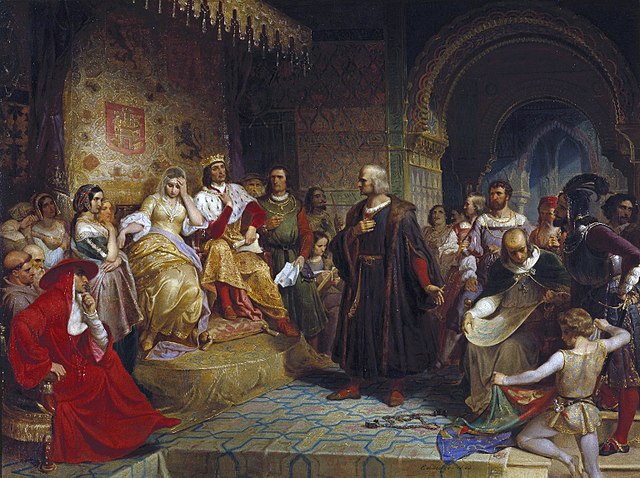
There he met his wife, Filipa Perestrelo e Moniz, who will give him three sons. Columbus will make several trips to the shores of Africa with Portuguese Merchants, learning navigation and cartography. He also becomes aware of the long duration of these coastal voyages along the great continent, and became convinced of the possibility of reaching the Indies by heading directly in high seas to the west. The cornerstone of his belief was Ptolemy’s own circumference of the earth was overestimated, and he himself estimated the distance from Europe to Cypango (Japan) to at most 2414 kilometers.
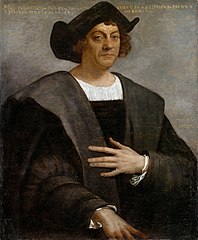 He established a strong case in order to prepare any questioning of the inquisitors, pleading in 1485 his project with King Manuel II. The latter, influenced by hostile advisers, categorically refused. Disappointed, Columbus leaved for Castile and he was accepted at the court of King Ferdinand of Aragon and Queen Isabella of Castile.
He established a strong case in order to prepare any questioning of the inquisitors, pleading in 1485 his project with King Manuel II. The latter, influenced by hostile advisers, categorically refused. Disappointed, Columbus leaved for Castile and he was accepted at the court of King Ferdinand of Aragon and Queen Isabella of Castile.
But a first verdict is unfavorable to him in 1490. He retains his luck in 1491 and this time, his project is in the process of obtaining the approval of the King. But the demands of Columbus for his titles and the power he asked for on the lands to discover provoked a new refusal. It was the Queen’s counselor who finally convinced her to accept the expected benefits of such an expedition.
In August 1492, Columbus was ready to leave with three ships, the Santa Maria, and two small Caravels, the Nina and the Pinta, and 90 men. On October 12, after a difficult and demanding journey for Columbus and especially for his crew accustomed to sailing by coast sight and frightened by stories of monsters and periles in the high seas, threaten the expedition to fail. Columbus, a poor diplomat, narrowly escaped one mutiny, saved by the captain of the Nina, his faithful Martin Pinzon.
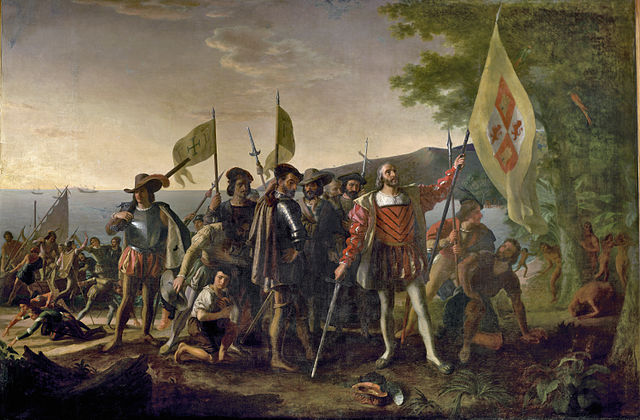
On the 12th of October, then, Columbus landed on the island of Guanahani (San Salvador), and greedy for gold, was led by the Indians farther north to Cuba. His expedition finally took foot on the island further west, named at the time Hispaniolia (Haiti). But the sea conditions had made the carrack unusable and she had been used to build a permanent establishment.
A handful of men were left behind, and Columbus set out again on the Nina up-river, joining Pinta earlier to search for gold further to the west. The return was also difficult, but triumphal. He bring back various artifacts, natives and animals, that attracted much interest, but no or little gold,. Despite some reulctance he convinced the court to the constitution of a larger fleet, counting 15 ships and 1500 men in order to establish a durable colony.
He left Cadiz in 1493 and arrived at Hispaniola, discovering the Fort Navidad without any living soul, while the fort was badly damaged leaving survivors dying ofhunger and illness and the hostility of the “Indians” . Columbus therefore started a new colony, called Isabella on another site. He stayed for a while to manage it, with his two brothers. His chief idea was always to find gold, and he went to explore southern Cuba with three caravels. He returned without new discoveries in 1496.
For his third voyage, in 1498, he was able to arm only 8 ships, and had to divert 5 on Hispaniolia because of shortages. Turning to Trinidad he thought he had finally found the continent. But the situation remained worrying to isabella, and colomb is soon accused of being the bad manager.
The King sent his adviser Bogadilla to shed light on these denunciations, and the report led to sending both Colomb brothers to be judged in Spain; Columb is effectively condemned, lost his titles and as a governor of Isabella, but receiving the endorsement for a new exploration mission, his fourth and last trip, in 1502.
This time he explored the shores of Honduras, discovered the isthmus of Panama that he mistook for the passage of Malaysia; But his expedition turned to drama, he lost his ships. He was rescued eventually by the grace of the new governor of Isabella, and returned to Seville where he ended his life without much fame or fortune, passing away in 1506.
São Gabriel
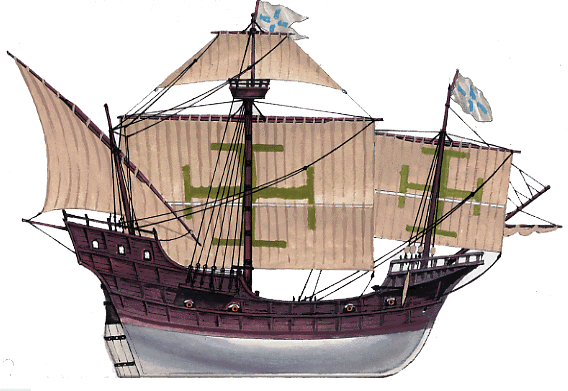
It was the most famous flagship of Vasco da Gama.
Vasco da Gama was born in 1468 in Sines. He was the son of a nobleman of the region, Estevão da Gama, but as a younger brother neither inherited the title nor the land, due to his brother. Frustrated, he had to choose between a career of ecclesiastical or military. This was his last choice. Attempted by adventure, he was very early acquainted with the things of the sea.
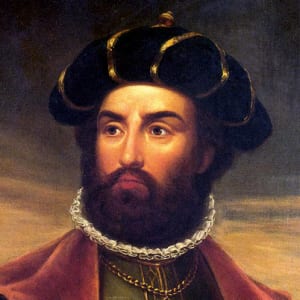 An officer, a fierce warrior eager for a title and recognition, confirmed sailor, he took part in numerous expeditions in Africa and the Mediterranean against the Turks. His youth had been lulled by accounts of the voyages undertaken nearly a century before by the first sailors of the African coasts under the impulse of Henry the Navigator.
An officer, a fierce warrior eager for a title and recognition, confirmed sailor, he took part in numerous expeditions in Africa and the Mediterranean against the Turks. His youth had been lulled by accounts of the voyages undertaken nearly a century before by the first sailors of the African coasts under the impulse of Henry the Navigator.
Conspiracies were thus opened as far as Guinea. Under John II, the Perfect, the attempt was made to go even further, the ultimate goal being to join the Indies where the trade in spices was most profitable. A first expedition in 1482 enabled Diego Cão to reach the mouth of Zaire. Then in 1486, he explored the coasts of Angola. In 1487 Batholomeu Diaz succeeded in reaching the first Cape of Good Hope, and in 1488 doubled it.
In 1487 the King sent Pero da Covilhã by land to contact Oriental potentates to verify the validity of certain information, but especially the establishment of diplomatic relations and possibly an alliance with the mysterious “Priest john” (a legendary sovereign of an Oriental Christian kingdom, possible allusion to Armenia), which would have made it possible to counterbalance Ottomans. But the emissary of the King, pushing into Abyssinia and India, was able to bring back only information on navigation on the East African coasts.
The King had spoken of the courage of Vasco da Gama and entrusted him with several missions. But the history of the expeditions stopped temporarily. John II had to face a serious internal crisis, in particular financial, and was facing the Spanish ambitions. He had to resolve to sign the Treaty of Tordesillas in 1494, dividing the world between two spheres of influence. The king perished the following year, perhaps poisoned.
His successor, Manuel I, restored the privileges associated with titles of nobility, and Paulo da Gama, Vasco’s brother, was given the command of a fleet of exploration to India. But Paulo, suffering, “passed his hand” to his younger brother, recommending him to the King. Vasco found himself thus in 1497 appointed by the King at the head of a small flotilla of three naos. (Or caracas):
It was the São Gabriel, its flagship, São Rafael commanded by its brother Paulo, both of 90 tons, Berrio of 50 tons, commanded by Nicaulo Coelho, and finally an old caravel of 110 tons loaded with provisions and water, commanded by Gonçalo Nunes. The flotilla sailed from Belem on July 8, 1497. She first sacked with the old and famous bartholomew Diaz, at the head of her own expedition to the São Jorge da Mina counter on the West African coast.
The flotilla, first rallying the Canaries, set sail for the Cape Verde islands, to refuel and repair the ships before returning to the sea on August 3, and rejoined the Gulf of Guinea. Bartholomeu left his compatriot by saluting him with a volley of white guns, then Da Gama resumed his journey following the wind, which led him to the open sea in the south-west before the latter turned south and brought back to the east.
93 days passed before the land was reported. The temperature had decreased, the wind was more violent. On the 7th of November he set foot on the coast at a point named by Diaz, Santa Helena. Taking again towards the south after having refueled, the expedition was in sight of the cape on the 18th of November.
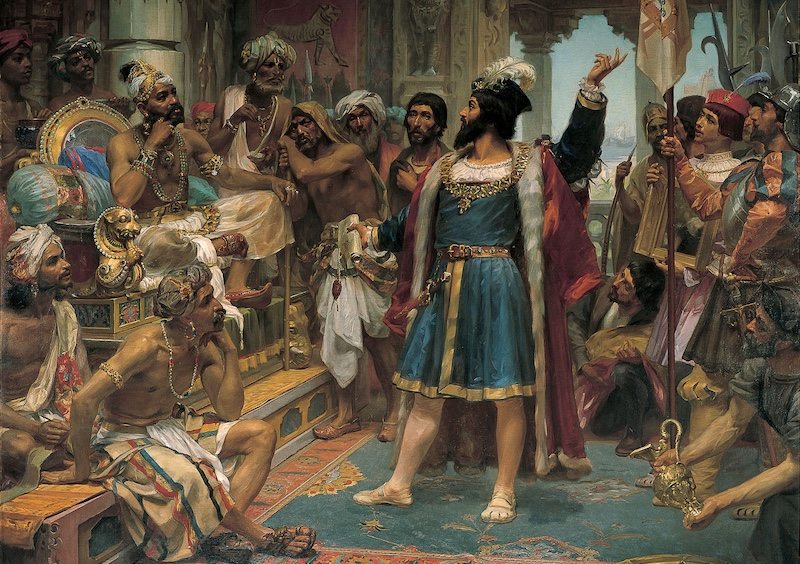
Vasco da Gama before Zamorin of Calicut, by painter Veloso Salgado, 1898
But at that moment, the heavy weather and the threatening sky gave the crew a feeling of fear. Vasco saw for himself that the nickname given by Diza of “Cape of Storms” was not usurped. The frail caraques were swept up by the immense blades, the crests of which crumbled without ceasing their oak frames. The hatches had been closed, but the sailors on deck kept bailing.
Da Gama made a series of round trips between the coast and the south, emerging from the storm to obtain a respite, but facing a contrary wind pushing it towards the west, and returning south to take advantage of the strong winds. A look-out informed him as soon as the land was in sight: The ships resumed to the south. In this way he thought, we were going to be able to cross the cape.
If his crew were exhausted and terrified, his resolve was unwavering. At last, on the 25th, after seven days of sailing, the winds of wind were more clever, and the ground was again signaled. The course was finally crossed. They made a release in the same cove where Diaz had completed his expedition years before, refueling and repairing their ships. The last provisions were taken from the old ship-shop ordered by Nunes and burnt as planned.
On the 7th of December Vasco da Gama set out again towards the North. In view of a coast on Christmas Day, he baptized Natal. A storm rejected him on January 11 at the coast where he landed on the “land of good people”, baptized as a result of his warm welcome by the natives. On the 23rd he touched land at a place called the land of the “Sinai Bons” in reference to the darker complexion of the inhabitants, a sign of an approaching East.
There they were again warmly welcomed, the inhabitants taking them for Turks; But on the spot Vasco de Gama found neither Christians nor any “priest John” signs. It does not matter: The flotilla remains on the spot 32 days, spent repairing the ships and trying to establish commercial relations.
A good part of the crew is exhausted and sick, and Paulo De Gama, appreciated by men, tries to temper the anger of his brother. On the last day before departure, Vasco de Gama had a stone marker bearing the Royal Portuguese coat of arms, marking his passage. He sailed on the 24th February towards the North.
On 2 March, it is in sight of the island of Mozambique. Again his ploy works. When he disembarked, he and his men disguised themselves as Turks. Everywhere the welcome is warm. Everywhere there are also encouraging signs abounding: They encounter dhows laden with gold, silks, gems and spices.
The local Sultan even agrees to provide them with two pilots to join Calicut. But the Arab merchants present, fearing for their comercial monopoly, denounce the true identity of the Portuguese. The Sultan immediately changed his behavior; Sensing the sulfur, Vasco joins his fleet on two launches when attacked by six armed dhows.
Paulo then intervenes with the Berrio, sending a volley to the address of the ships which fold down on the coast. Vasco da Gama, by retaliation, will bombard the city with his three ships. Then they resumed their journey and on March 7 they stopped at Mombasa. A Portuguese seafarer, who sniffs a trap, prefers to anchor outside the harbor.
That does not prevent his men from disembarking and refueling. warm business relations are even undertaken. Finally the Sultan agrees that the flotilla will be anchored in the harbor. But Vasco da Gama smells a trap and his ships leave, without his two pilots who jumped to the sea and swam to the coast in a moment of inattention.
On 15 April the squadron returned to Malindi, and the local Sultan was friendly. He succeeded in lulling the Portuguese’s vigilance, and the latter freed the Moorish hostages captured in Mozambique, while the Sultan agreed to provide them with a Portuguese-speaking pilot as far as Calicut. The squadron resumed the sea on the 24th, and the captain-major, who thought to impress the pilot, Malemo Canaca, showed him a sextant.
The latter, to the great surprise of Vasco da Gama, revealed what he recognized as a “ladder of Jacob”, an old measuring instrument brought to Arab scientists by Jewish merchants in the past and, above all, a very detailed Arab map of any the East African coast and India.
On the 20th of May, after having rapidly crossed the Indian Ocean, the Portuguese anchored in the port of Calicut. They are impressed by the splendid architecture, the fountains, the brilliant streets and the parks. The welcome, however, is mixed.
Again, Vasco looks for signs of Christendom and finds none. They are granted a hearing by the Zamorin on 28 May. The Captain-Major brings to Manuel I the portrait of a powerful and influential sovereign in Europe, and the Zamorin sketches his desire to negotiate for an alliance. But the next day, the “presents” granted by Vasco Da Gama to the local ruler, which resemble pale merchandise for natives, displeased him. De Gama forbids himself to be a merchant, but only an ambassador. Little diplomat, he leaves the relationship fester.
The suspicions of the Zamorin, maintained by the Arab merchants, reached the point where he forbade the Captain-Major to return to his ships. He is a prisoner in the palace. Vasco succeeded in contacting one of his men outside and charged him with a message for his brother, asking him to anchor and join Portugal, and to return in force.
But, on the contrary, the latter approaches the coast and prepares to bombard the city. The landemain, the Zamorin agreed to relay Gama, but the resentment of the Moors is palpable. The latter supervise him on his return to the quays, and the captain-major, exasperated, is to draw the sword when his brother intervenes and begins a new commercial relationship. Resentment subsides and business resumes.
But soon, the Zamorin will again change his mind and take hostage the sailors of Sao Gabriel. Finally, Vasco Da Gama will leave Calicut and also take hostages. It will remain off, preparing for a possible return, and ultimately the Zamorin will release the Portuguese hostages, demanding that Vasco do the same, and the return journey could begin on August 29, this time with commercial and diplomatic agreements.
The first stop was on the island of Anjediva, where the forests allowed the three vessels to be repaired and dryed for a fairing. Then the Portuguese took the road again towards Malindi. Unfortunately, the Sao Rafael was the victim of a navigation error and came to be dropped on the coast.
Unusable, it was evacuated and burned. Then the squadron reduced to Sao Gabriel Berrio and resumed his journey, rounded the Cape, joined the Gulf of Guinea, and split into two, Nicolau Coelho on Berrio with the task of directly ralier Lisbon, while Gama was transiting his other caraque to the islands of Cape Verde, to remain with his dying brother. His return was no less triumphant, with 55 men out of the 150 parties a year earlier.
Manuel II thanked him princely, granting him titles and the city of Sines, a living allowance for his descendants. Dom Vasco de Gama, Married to an artist, Catarina de Ataíde, took the title of Count of Vidigueira. In 1502 he was made “Admiral Persian sea, Arabs, Indians, and all the Eastern seas”, and invited to take command of a new much more ambitious shipping fleet of 20 carracks and caravels.
This time it is a matter of opening permanent trading posts in India. He sailed from Lisbon on 10 February. On 12 June, he passed through Kilwa, which he bombed on learning of the persecution that had been the victim of Cabral shortly before. The inner demons of Vasco da Gama are then expressed in broad daylight: The admiral sets sail on the red sea that he furrows and ransoms and sinks all the Arab merchant ships he crosses.
But when he crosses paths with a ship from Calicut, he commits the worst: Taking hostage children the edge to make Christians, it sinks the ship with the rest of his crew, not n’pargant women , and then hanged and cut off the hands of his other prisoners, in order to display them in trophies at the Zamorin.
Arriving in Calicut, he demanded that the latter should expel the Arab merchants from the city. In refusing to do so, the latter sees his city bombed two days and two nights by the Portuguese fleet, which nothing stops. Feeling in force, he has signing commercial agreements favorable to Portugal in the Kingdoms of Cochin and Cananor where he establishes counters and then build fortresses on the coast. Then he sets off again to Portugal, the holds full of oriental spices.
On his return to the country, Vasco profited by his titles and position for some twenty years, before the new King John III invited him to attempt a new expedition, with the title of Viceroy of India. In particular, he was to restore the King’s authority to the local governors, who took a little too much liberty.
On the 9th of April, 1524, his squadron left Lisbon. But old Dom Vasco da Gama, who had arrived on the spot, could not exercise his authority as Vice-King for three months. Tired and sick, he died on December 25, 1524 in Cochin. Later on a sculpture was erected of a lying figure, which was placed with its remains in the monastery of Geronimos, next to the poet of the Lusiades, Luis de Camões, who for centuries made it a mythical hero.
HMS Mary Rose
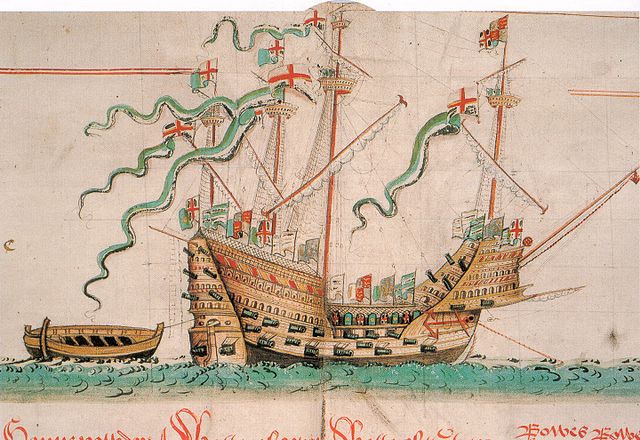
On his accession to the Throne in 1509, Henry VIII inherited the nucleus of a navy created by his father in the form of five ships, including Regent caravans and Sovereign. This fleet could be extended by buying or leasing merchant ships, both domestic and foreign, sometimes transformed into lightly armed warships with archers and some firearms. Other ships could be financed by the nobility.
The Mary Rose is undoubtedly one of the most famous Caraques of the English fleet at that time, more famous than the Great Harry who followed.
Faced with the ever-present threat of the French navy, as well as the potentially hostile Scottish fleet, Henry undertook a shipbuilding program, including the Mary Rose.
According to Nam Rodger (The Salvage of the Sea: A Naval History of Britain Vol. 1) the threat of new Scottish vessels, including Michael and Margaret, was undoubtedly the determining factor in the King’s decision to extend and reinforce Marine. From a technological point of view, these new ships had nothing to do with the elders, they were heavy caravels rather than clinquarts, equipped with heavy weapons mounted near the waterline.
Although the loss of Mary Rose is well documented, the ship’s construction is not. There are, however, some documents that provide important clues as to where and when it was built. A private Venetian letter dated 29/12/1999 referring to an increase in the price of tin because the king manufactures bronze cannons to equip four new ships built in Southampton.
However, neither the names or the tonnage of the vessels are recorded. There is also a mandate given to John Dawtry on 29/1/1510, authorizing a grant of £ 700 for building materials for a 400-ton vessel and a 300-ton vessel. Seven hundred pounds followed by other endowments. The sails, strings, lines, ropes, cables, shrouds, bouyropes, ticks, elevators, top tacks, coils, compasses, racing glasses, bowls, dishes, lanterns, pulleys, provisions and salaries are also noted.
The supposed ships were the Mary Rose and Peter Pomegranate respectively, only two large new ships registered as built in March 1510 in Portsmouth. There was present Robert Brygandine, clerk of the king’s ships in 1495 and generating state documents. Some texts even doubt the existence of the ship, called and often confused with the “great galley” of the Tudors.
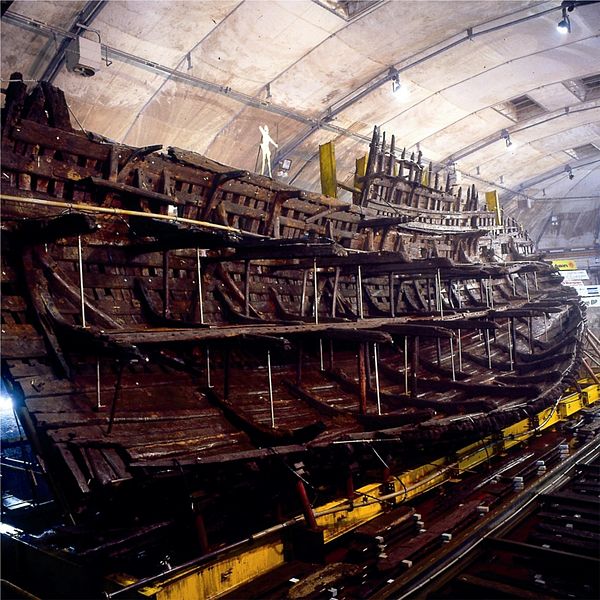
After its launch Mary Rose participated in the first war of the young Henry VII, which will last from 1511 to 1514. England threatened to the North by Scotland and to the south by the French was the holy league, Spain, Venice and the Papacy.
His alliance with Ferdinand of Aragon, through his Marriage, obtains that the King of Spain will attack France before the end of April 1512. The fleet begins by making sure of the control of the Channel, capturing 12 Bretons and French ships. In June-July under Lord Howard, the fleet led an expedition to Brittany, the troops burning villages and capturing knights for ransom.
After spending some time in repairs the fleet attacks Brest in August. A great battle ensued, the first with ships having these new heavy batteries in portholes. The Mary Rose attacked the French flagship, forcing her to leave the line with 300 dead and injured, her main mast being cut by a shot on goal.
The high point of the battle arises when a “400-tonne ship”, probably Peter Pomegranate, knocks out the “Carraque de Brest” or “de la Reine” and the great caraque Marie-la-Cordelière 400 to 1500 tons). The Regent caught fire after the entry of the English, and two thousand men were killed. On the English side, the loss of Sir Thomas Knevet (the captain) and Sir John Carew was lost. The English fleet continued its journey by capturing 32 other ships and then retreated to Dartmouth and Southampton.
Before the campaign of 1513, and after the naval review of Greenwich, the fleet, by order of the King, made a regatta to the Strait of Dover, of which Mary Rose emerged victorious, with the greatest admiration of Lord Howard. Subsequently the caraque with the rest the fleet launched a blockade of Brest and disembarks a company of 1500 men who burns and plunder the coast.
However, the French counter-attack with the fleet of galleys of Pregent de Bidoux, sink an English ship and withdraw to Whitsand Bay near Conquer. Lord Howard will attack these galleys by his boats, galleys and Crayers, two of his admirals embarking. One of them will leave his life and the attack will be a failure. It will even give rise to a certain fear of these Breton galleys, and desertions.
Remember Lord Howard will then wage war against the Scots, sinking the Lion and the Jenett of Purwyn. Later the Scots invaded England but were defeated at the Battle of Flodden. Henry VIII will relaunch the war in France, Mary Rose being implicated of operations allowing the recapture of Therouanne and Tournai, then the siege of Calais in October. The caraque was back in Portsmouth for the winter.
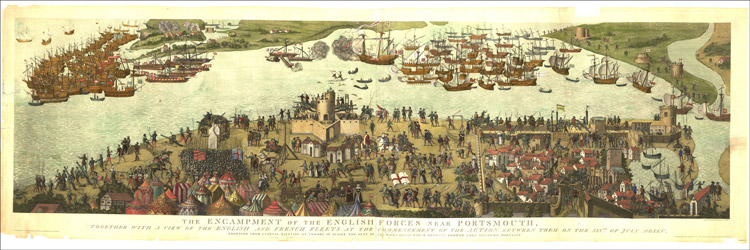
Battle of the Solent in Portsmouth
One hears more about the ship with the Peace signed with France until 1518, its caulking being redone between the 5 of August and 26 of November. When the war was repre- sented in 1522-1525, the Mary Rose remained in support on the coast while an English Army reached 80 kilometers from Paris, aided by the Spaniards and the rebellion of the Duke of Bourbons. But Charles’s army is not very reactive and the rebellion fails, while the English army at the bottom runs out and must withdraw, although in Italy at the same time the French army is beaten in Pavia.
The carcass then retreated to Deptford for a complete reconstruction in 1525. The reconstruction is pushed by a complete overhaul at Portsmouth in 1528. Another redesign will take place in 1536. On this date the King of France obtained from the ambassador Prillac the postponement of the three largest units of the fleet, the “Pomegranate”, the Mary Rose and the Great Harry.
The war resumed in 1542, but it is not known whether Mary Rose participated in the operations against Scotland or France. What is known however, is that the caraque was in October 1544 in operations off Boulogne, preventing any exit of the French between Douvre and Calais/Boulogne. A battle ensued on 21 June 1545 in Alderney with French galleys (defeat of the last apparently).
However the French line fleet entered the Solent with the intention of crossing the iron with the English fleet in July. This fleet consisted of 200 vessels, including 23 galleys. The English manage to collect 80 ships and prepare for a defensive battle.
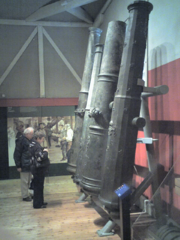 The battle of the Solent will see the unexpected end of Mary Rose. Francis I left the ship-admiral Carraquon (burnt) and Admiral D’Annebault made his mark on La Maistresse, en route to the island of White. The battle began with an engagement of the French galleys, after which the Mary Rose sank, under circumstances that still seem unclear.
The battle of the Solent will see the unexpected end of Mary Rose. Francis I left the ship-admiral Carraquon (burnt) and Admiral D’Annebault made his mark on La Maistresse, en route to the island of White. The battle began with an engagement of the French galleys, after which the Mary Rose sank, under circumstances that still seem unclear.
It is very unlikely that this is the result of the galleys and their weak artillery, their only role being to attract the English towards the bulk of the French fleet. One of the survivors testified that the ship was flying in the wind to the point where its lowest ports were taken by water (this is also the official report of Sir Walter Raleigh and Burchet.) According to John Hooker, Mary Rose began to roll abnormally as soon as the sails were erected, while another reported the indiscipline of the gabiers???, who would not have folded the sails when asked, and afterwards Venetians tried unsuccessfully to refloat the carrack.
The Mary Rose was spotted again in 1836 when a fisherman saw his nets caught in the sandy structure as later discovered by the diver John Deane. He later removed bronze cannons and some artifacts but the wreck returned into the darkness; In 1965, Alexander McKee continued his international attention.
He launched an attempt with his diving club to find the ships of this famous battle of the Solent. He will be able to set up a sonar research with Professor Harold E. Edgerton (MIT) and John Mills, the site being finally discovered and explored from 1968 to 1971. Extraordinary, the Mary Rose will finally be extracted from the mud in 1985, will be treated and protected, then exhibited in a specially designed museum, now an attraction of Portsmouth. This is the only example of a carrack of that time with this level of preservation. The Swedish Vasa, built much later, was a much more modern vessel, with more than 100 years of gap.
Renaissance ships poster
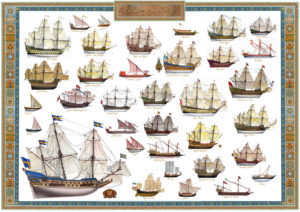
Postcards

Great Carrack of Malta Knights

Turkish Tchektirme, typical cargo
Books:
Encyclopedia Ships: Gibbons, Ford, Hewson, Gibson
google books the culture of piracy 1580-1630
Google books Venetian ships and shipbuilders from the renaissance
Google books – Exploration in the Renaissance By Lynne Elliott
War at Sea in the Middle Ages and the Renaissance edited by Ernest J King Professor of Maritime History Chairman Maritime History Department and Director Naval War College Museum John B Hattendorf, John B. Hattendorf, Richard W. Unger
Presentations:
Types of Renaissance Ships Jalyne Berry.
Documents (pdf):
Mobility & Space in Late Medieval and Early Modern Europe by Mirko Sardelić (Oxford)
History of Cartography in the Renaissance by David Woodward
Shipbuilding Practice and Ship Design Methods From the Renaissance to the 18th Century
Illustrated History of Ships & Boats by Lionel Casson 1964
The origin of the science of hydrostratic stability
About Renaissance cartography and sea monsters
Read More about renaissance ships:
Page on Renaissance ships and navigation

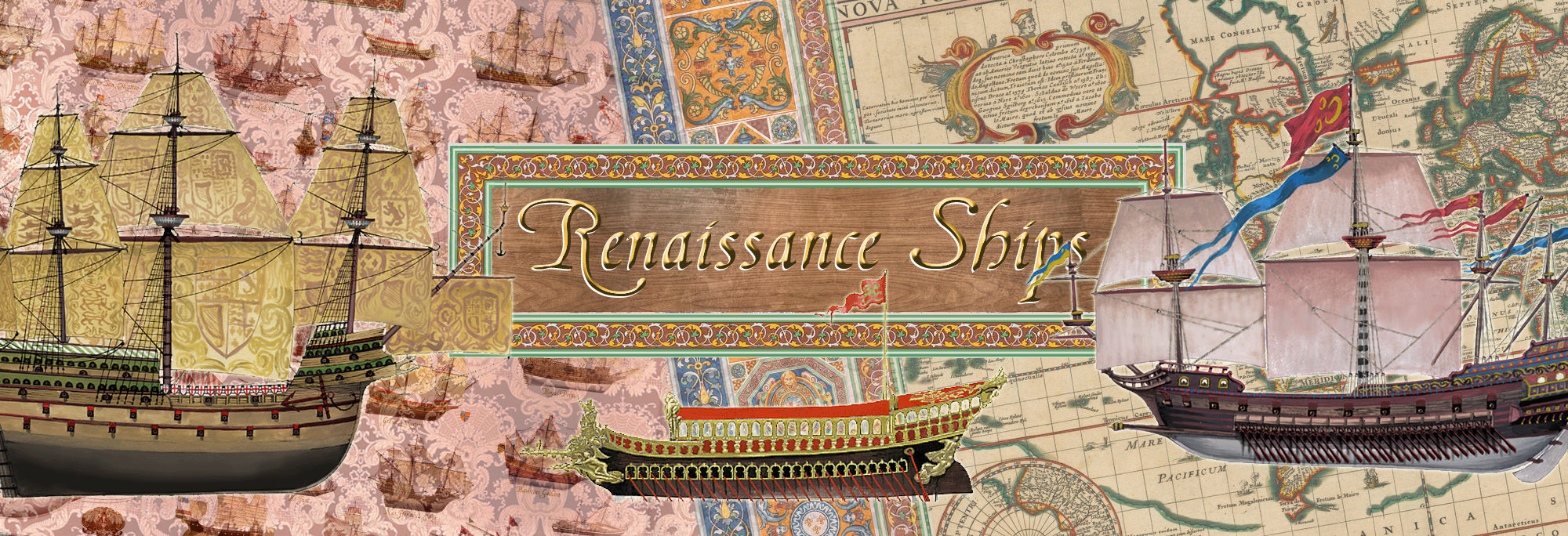
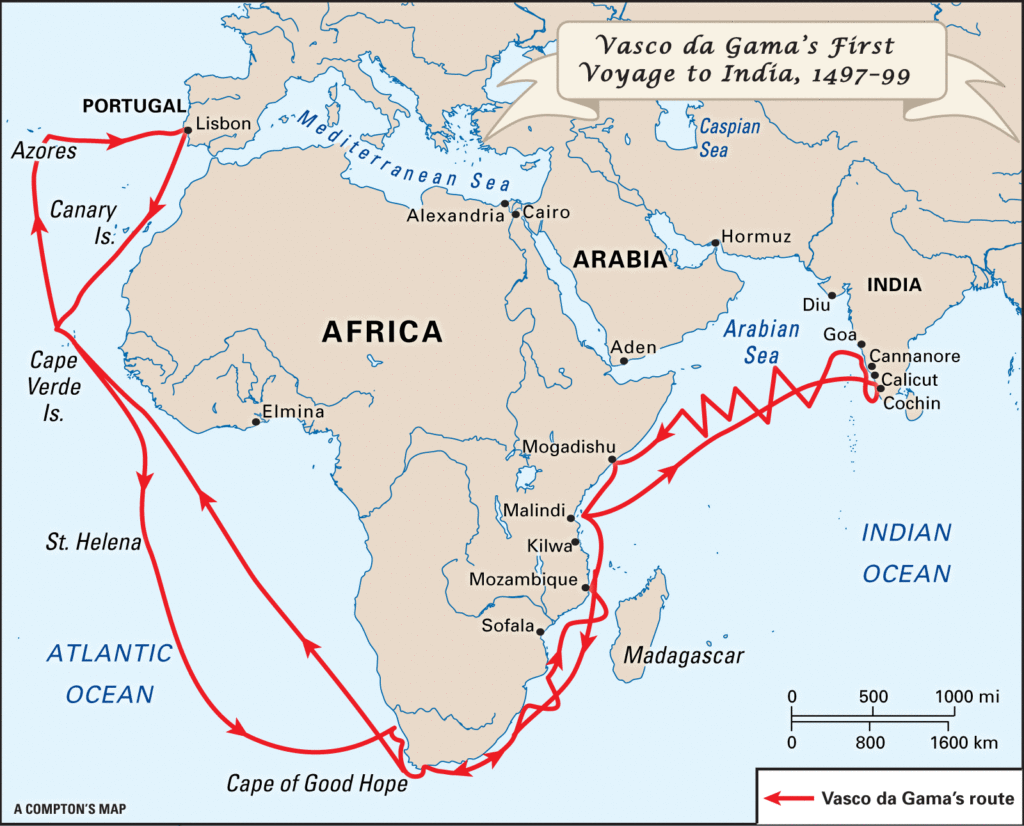



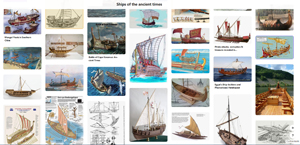
 Latest Facebook Entry -
Latest Facebook Entry -  X(Tweeter) Naval Encyclopedia's deck archive
X(Tweeter) Naval Encyclopedia's deck archive Instagram (@navalencyc)
Instagram (@navalencyc)





 Austrian Navy
Austrian Navy French Navy
French Navy Royal Navy
Royal Navy Armada Espanola
Armada Espanola K.u.K. Kriegsmarine
K.u.K. Kriegsmarine Dansk Marine
Dansk Marine Nautiko Hellenon
Nautiko Hellenon Koninklije Marine 1870
Koninklije Marine 1870 Marinha do Brasil
Marinha do Brasil Osmanlı Donanması
Osmanlı Donanması Marina Do Peru
Marina Do Peru Marinha do Portugal
Marinha do Portugal Regia Marina 1870
Regia Marina 1870 Nihhon Kaigun 1870
Nihhon Kaigun 1870 Preußische Marine 1870
Preußische Marine 1870 Russkiy Flot 1870
Russkiy Flot 1870 Svenska marinen
Svenska marinen Søværnet
Søværnet Union Navy
Union Navy Confederate Navy
Confederate Navy Armada de Argentina
Armada de Argentina Imperial Chinese Navy
Imperial Chinese Navy Marinha do Portugal
Marinha do Portugal Mexico
Mexico Kaiserliche Marine
Kaiserliche Marine 1898 US Navy
1898 US Navy Russkiy Flot
Russkiy Flot French Naval Aviation
French Naval Aviation Russian Naval Aviation
Russian Naval Aviation Sovietskiy Flot
Sovietskiy Flot Royal Canadian Navy
Royal Canadian Navy Royal Australian Navy
Royal Australian Navy RNZN Fleet
RNZN Fleet Chinese Navy 1937
Chinese Navy 1937 Kriegsmarine
Kriegsmarine Chilean Navy
Chilean Navy Danish Navy
Danish Navy Finnish Navy
Finnish Navy Hellenic Navy
Hellenic Navy Polish Navy
Polish Navy Romanian Navy
Romanian Navy Turkish Navy
Turkish Navy Royal Yugoslav Navy
Royal Yugoslav Navy Royal Thai Navy
Royal Thai Navy Minor Navies
Minor Navies Albania
Albania Austria
Austria Belgium
Belgium Columbia
Columbia Costa Rica
Costa Rica Cuba
Cuba Czechoslovakia
Czechoslovakia Dominican Republic
Dominican Republic Haiti
Haiti Hungary
Hungary Honduras
Honduras Estonia
Estonia Iceland
Iceland Eire
Eire Equador
Equador Iran
Iran Iraq
Iraq Latvia
Latvia Liberia
Liberia Lithuania
Lithuania Mandchukuo
Mandchukuo Morocco
Morocco Nicaragua
Nicaragua Persia
Persia San Salvador
San Salvador Sarawak
Sarawak Uruguay
Uruguay Venezuela
Venezuela Zanzibar
Zanzibar Warsaw Pact Navies
Warsaw Pact Navies Bulgaria
Bulgaria Hungary
Hungary

 Bundesmarine
Bundesmarine Dutch Navy
Dutch Navy Hellenic Navy
Hellenic Navy Marina Militare
Marina Militare Taiwanese Navy
Taiwanese Navy Chinese Navy
Chinese Navy Indian Navy
Indian Navy Indonesian Navy
Indonesian Navy JMSDF
JMSDF North Korean Navy
North Korean Navy Philippines Navy
Philippines Navy ROKN
ROKN IDF Navy
IDF Navy Royal New Zealand Navy
Royal New Zealand Navy Egyptian Navy
Egyptian Navy South African Navy
South African Navy

































 RN
RN
 Marine Nationale
Marine Nationale
 Soviet Navy
Soviet Navy
 dbodesign
dbodesign